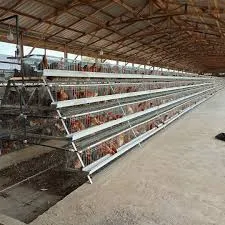cage poultry farming
Dec . 11, 2024 12:02 Back to list
cage poultry farming
The Advantages of Cage Poultry Farming
Cage poultry farming has emerged as a popular method of poultry rearing, particularly in the commercial egg-laying industry. This method involves confining chickens in cages to optimize space, streamline management practices, and improve overall productivity. While cage systems have their critics, they also offer numerous advantages that contribute to the efficiency and sustainability of poultry farming.
Enhanced Space Utilization
One of the most significant benefits of cage poultry farming is efficient space utilization. Cages allow farmers to house a larger number of birds in a relatively small area. This high-density housing is essential for commercial operations, where maximizing output is paramount. In cage systems, birds are typically housed in tiers with multiple levels, enabling farmers to increase their flock size without needing to expand their physical footprint. This concentrated living arrangement not only makes better use of land but also simplifies management, as all birds are more accessible for feeding and monitoring.
Improved Biosecurity
Cage poultry farming also enhances biosecurity measures. Because the birds are kept in individual cages, there is a lower risk of direct contact between them, which reduces the spread of diseases. This advantage is particularly important in commercial settings where disease outbreaks can lead to significant financial losses. Innovative cage designs often include features like automatic feeding and watering systems that minimize human contact and help maintain a sanitary environment. By reducing the potential for infection, farmers can maintain healthier flocks and, consequently, more consistent production rates.
Better Management of Welfare
cage poultry farming

Although cage farming has faced criticism regarding animal welfare, modern cage systems have evolved significantly to address these concerns. Enriched cages, for example, provide birds with additional space and amenities such as nesting areas, perches, and dust baths. These improvements foster more natural behaviors among the hens, leading to better overall well-being without compromising the efficiency of production. Additionally, by controlling factors such as temperature, humidity, and lighting within the cages, farmers can help ensure that the birds are raised in optimal conditions.
Cost-Effective Production
Cage poultry farming can lead to a more cost-effective production model. The efficiency gained through higher stocking densities and improved bird health translates into reduced feed costs and increased egg production. Farmers can monitor individual birds for health and productivity, allowing for proactive management and reducing waste. This cost-effectiveness is critical in a competitive market where price pressures are intense, enabling farmers to maintain profitability while producing high-quality eggs.
Environmental Considerations
While the environmental impact of poultry farming is a significant concern, cage systems can also present solutions. By concentrating waste, farmers can implement more effective manure management strategies, including composting and biogas production. This method not only manages waste effectively but can also convert it into a resource. Furthermore, by streamlining operations and increasing production efficiency, cage systems can potentially lower the overall carbon footprint associated with poultry farming.
Conclusion
Cage poultry farming represents a pragmatic approach to modern poultry production, balancing efficiency, economic viability, and animal health. With innovations continuously improving the welfare of the birds and the sustainability of farming practices, cage systems are likely to remain a cornerstone of commercial poultry farming for years to come. While it's crucial to continue addressing welfare concerns, the advantages of cage poultry farming—such as space utilization, biosecurity, cost-effectiveness, and environmental management—make it a compelling choice for producers aiming to meet the growing global demand for poultry products. Ultimately, a combination of responsible practices and technological advancement can ensure that cage poultry farming remains a viable and ethical option in the agricultural landscape.
-
Automatic Feeding Line System-Pan Feeder Nipple Drinker|Anping County Yize Metal Products Co., Ltd.
NewsJul.29,2025
-
Hot Sale 24 & 18 Door Rabbit Cages - Premium Breeding Solutions
NewsJul.25,2025
-
Automatic Feeding Line System Pan Feeder Nipple Drinker - Anping County Yize Metal Products Co., Ltd.
NewsJul.21,2025
-
Automatic Feeding Line System Pan Feeder Nipple Drinker - Anping County Yize Metal Products Co., Ltd.
NewsJul.21,2025
-
Automatic Feeding Line System - Anping Yize | Precision & Nipple
NewsJul.21,2025
-
Automatic Feeding Line System - Anping Yize | Precision & Nipple
NewsJul.21,2025






